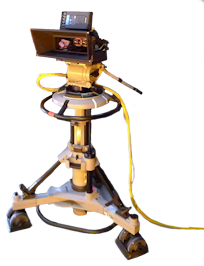3D-TV
'3D-TV' is the general name for television systems which allow the viewer to perceive 'depth' in the scene he watches. Our perception of depth is linked to many elements in the scene, such as size of objects, texture, etc. One of the most important for objects close to us is the difference seen by the left and right eye ('binocular disparity').
Fixed viewpoint
Current 3D-TV systems reproduce this binocular disparity at one fixed viewpoint. These are usually called stereoscopic television systems, or (more accurately) 'plano-stereoscopic television. There are a number of ways of carrying and reproducing the left and right eye signals for the viewer. Most current systems require the viewer to wear special glasses, although some do not (auto-stereoscopic systems).
| Not new
The idea of providing left and right eye pictures is not new, and the basic concept has been applied for over 100 years. The Cinema has made 3D movies since the 1930s, and their popularity has risen and faded over the years. Most attention today is focussed on 'plano-stereoscopic' TV.
EBU 3D-TV Project Group
The EBU has had a 3D-TV Project Group, which is led by Andy Quested (BBC). In January 2013 this group has been closed as the objectives were met. Other EBU 3D-related activities include(d): |  |
- Contributing to standardisation in DVB, the ITU and SMPTE.
- Contribution to EU 7th framework projects, such as MUSCADE and 3D VIVANT.
- An EBU 3D Masterclass, organised together with Swiss EBU Member TPC (2010).
- An EBU 3D Master Class, organised at Twickenham Studios in the UK (2011).
- A Workshop on 3DTV and its health issues, held in Geneva at the EBU headquarter (2011).
- Creating a new set of 3D video reference sequences (2012).
